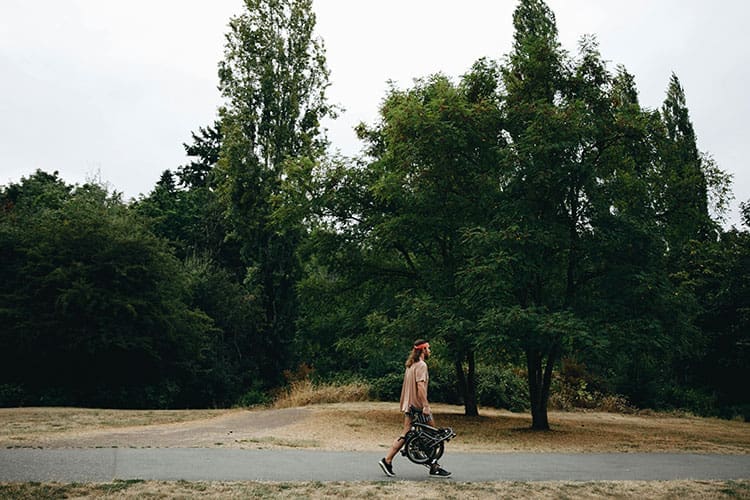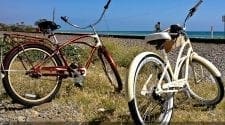Do you want to leave your urban cycling issues in the past?
Ok, we know what you’re going through.
Living in a big city and commuting long distances is a soul-destroying, wallet-emptying experience. Traffic jams, outrageous parking fees, crowded buses and no space at home for a regular bike all suck the joy right out of cycling.
But there’s a way out
We can help.
Folding bikes are different. A modern compact folding bike solves more issues than a traditional bicycle will ever manage to.
The demand for folding bikes is through the roof. According to the latest industry report, the global market is expected to reach $850 million in 2024 and grow to $1.9 billion by 2034. That’s annual growth of 8.5% and there’s no sign of it slowing.
Here’s the thing.
When you buy folding bikes from a huge range of available models, you’re not just buying mobility. You’re buying freedom.
What you’ll discover:
- Why Folding Bikes Are Taking Over Cities
- The Different Types You Need To Know About
- Key Features That Actually Matter
- How To Choose Your Perfect Folding Bike
- Real-World Benefits You Can’t Ignore
Why Folding Bikes Are Taking Over Cities
Let’s look at the hard numbers. According to urban population statistics, 55% of the world’s population is urban today. By 2050? That number is forecast to grow to 68%.
Translation: Cities are getting busier, parking is getting harder to find and the old ways of getting around are starting to fall apart.
Folding bikes are a perfect solution. They fold up to suitcase-size, fit on trains and buses, and can be stored under desks and in small apartments.
The Storage Revolution
Think about your current bike storage situation. Where do you keep it?
- Basement?
- Balcony?
- Chained outside praying it won’t get stolen?
Throw it away. Folding bikes free you from all that nonsense.
They fold in 30 seconds and you can store them:
- Under your desk at work
- In your apartment living room
- In car boots for weekend trips
- On public transport without the hate-eyes
Pretty cool, right?
Traffic Dodging Made Easy
Here’s another thing that few people seem to realize…
Folding bikes are great at mixed commuting. You can ride the bike part of your journey, fold it and hop on a train, then unfold the bike and cycle the last mile.
The upshot? No traffic congestion, no waiting for buses that never come on time, and no sweaty armpits.
This kind of freedom is why so many commuters are ditching conventional transport and hopping on a folding bike.
The Different Types You Need To Know About
To find your perfect bike, it helps to understand the different categories available. Here’s the rundown:
Vertical Fold Bikes
These have the largest market share, holding 43.2% of recent industry analysis. Here’s why:
The folding mechanism is dead simple. The frame splits in half and the bike folds vertically to make a suitcase-like shape. Super easy to wheel around.
Best for: Daily commuters looking for quick folding and easy transport.
Mid-Fold Bikes
The traditional style that most people think of as a “folding bike.” Frame hinges in center, bike folds in half horizontally.
Best for: Riders valuing comfort over compact folding size.
Triangle Hinge Bikes
Use a triangular hinge system to create very stable but slightly longer-to-fold bikes.
Best for: Longer distance commuters where ride comfort is more important than folding speed.
Key Features That Actually Matter
Don’t let marketing speak fool you, these are the features that are important:
Weight Matters More Than You Think
If the bike is too heavy, you’ll just leave it at home. Folding bikes need to be light, or they lose their point.
Shoot for 12kg or less. High-end models like the Brompton P-Line get down to under 10kg with titanium construction.
Folding Speed
If it takes more than 60 seconds to fold, you’ll never do it. The best bikes take 15-30 seconds.
Wheel Size Impact
- 16-inch wheels: Super compact but a bumpy ride
- 20-inch wheels: Best compromise of portability and ride
- 24-inch wheels: More comfortable, bigger when folded
Gear Range
3-8 gears are all you need for city riding. Bikes with more gears are just heavier and more complex than needed.
How To Choose Your Perfect Folding Bike
First, be honest about how you’re going to use this thing.
Answer these questions truthfully and you’ll find the right bike for your needs.
For Short Urban Commutes (Under 5 Miles)
Key needs:
- Quick folding
- Light weight
- Basic features
Single-speed or 3-gear bikes will do. Prioritize build quality, not fancy components.
For Mixed Commuting (Bike + Train/Bus)
Key needs:
- Compact folded size
- Decent ride quality
20-inch wheel bikes with 6-8 gears are ideal. Balance portability and comfort.
For Longer Rides (5+ Miles)
Key needs:
- Comfort
- Stability
- Gears
Look at 24-inch wheel models or high-end 20-inch bikes with suspension. The extra weight is worth it.
For Recreational Use
Key needs:
- Fun factor
- Versatility
Electric folding bikes are a growing segment. Worth the weight for easier longer rides.
Real-World Benefits You Can’t Ignore
Ok, so beyond being more portable than a regular bike, what else do folding bikes do?
Theft Protection
Say goodbye to bike theft. Bring your bike inside and there’s nowhere for thieves to lay their hooks.
Weather Independence
Rainstorm? Fold up the bike and jump on public transport. Not so easy with a conventional bike.
Travel Freedom
Folding bikes can come on planes, trains and in car boots. You’re no longer restricted to cycling in your home city.
Maintenance Simplicity
Fewer things to break means less maintenance. Folding bikes are known for being super reliable.
Health and Fitness
Small as they are, folding bikes are great exercise. The fact that you use them more means better fitness levels.
Wrapping It All Up
Folding bikes solve problems traditional bikes can’t. The unmatched convenience and storage freedom they offer, combined with the cycling options you never realized existed, change everything.
With 8.5% annual growth in the market and urban populations exploding, folding bikes are not going anywhere. The real question is which one you should get, not if you should get one at all.
Define your commute needs, take different types for a test ride and go quality over flash features. Do it right and you’ll never look back.
Photo by PNW Production
No products found.













